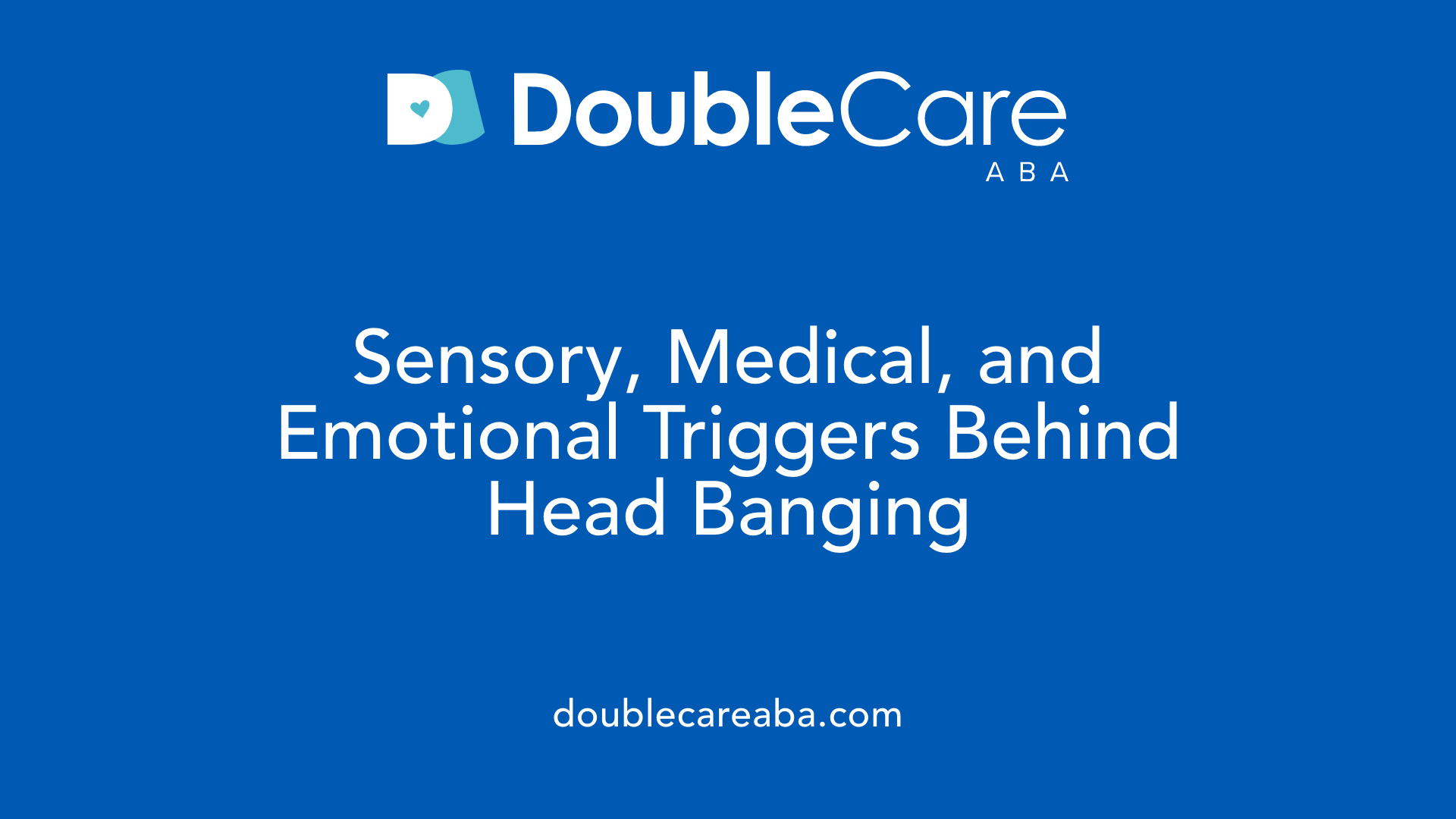Head Banging Autism
Understanding and Managing Head Banging in Children with Autism

Unraveling a Common but Complex Behavior
Head banging in children with autism is a prevalent behavior that often causes concern among caregivers and professionals alike. While it is typically a self-soothing or communication strategy, understanding its underlying causes, triggers, and appropriate interventions is crucial for ensuring safety and promoting well-being. This article explores the nature of head banging in autism, examines its causes and functions, and provides evidence-based strategies for management and prevention.
The Prevalence and Significance of Head Banging in Autism

Does head banging indicate autism?
Research suggests that head banging is one of the more common repetitive behaviors associated with autism. The prevalence varies among individuals and depends on factors such as age, level of functioning, and co-occurring conditions.
How common is head banging among children with autism?
It is estimated that between 20% and 50% of autistic individuals engage in some form of self-injurious behavior, with head banging being one of the most typical. Studies indicate that up to 20% of babies and toddlers with autism, especially boys, may exhibit head-banging behaviors.
At what age does head banging usually start and how long does it last?
Head banging often begins early, around 18 months to 3 years of age. Typically, the behavior peaks during early childhood and may spontaneously decrease as children develop better communication and coping strategies. However, in some cases, it can persist beyond age three, requiring medical and behavioral intervention.
Why is understanding head banging behavior important?
Understanding why children head bang is crucial because it often serves functions like communication, sensory regulation, or emotional coping. Recognizing triggers such as overstimulation, pain, or frustration helps caregivers address underlying causes. This knowledge allows for the development of effective interventions—using strategies like sensory supports, communication teaching, and environmental safety measures—to reduce injury risk and support the child's wellbeing.
Additional insights on head banging prevalence
Studies show that head banging, along with other self-injurious behaviors like skin picking, biting, or hair pulling, can cause physical injuries such as bruises, fractures, or even concussions if not managed carefully. Early identification and tailored interventions are essential.
| Aspect | Details | Additional Notes |
|---|---|---|
| Prevalence | 20-50% of autistic individuals | Varies depending on age, severity, co-occurring conditions |
| Typical age | 18 months to 3 years | Usually peaks early, may diminish over time |
| Duration | Can decrease spontaneously or persist | May require intervention if long-lasting or injurious |
| Reasons for behavior | Sensory regulation, communication, frustration | Understanding triggers is vital |
| Risks | Injury, interference with development | Safety measures and behavioral therapies are recommended |
This information highlights how common head banging is among children with autism and underscores the importance of understanding its functions for better management and support.
Causes and Underlying Factors Behind Head Banging

What causes head banging in children with autism?
Head banging is a common and complex behavior seen in children with autism. It serves many functions, from self-soothing to communication and emotional expression. Children may head bang to regulate their sensory input, either to stimulate themselves when understimulated or to decrease overwhelming sensations when hypersensitive.
Physical discomfort, such as ear infections or headaches, can also trigger head banging. Sometimes, children self-soothe by hitting their heads when feeling anxious, frustrated, or upset. Limited verbal skills may lead children to use head banging as a way to signal needs or discomfort, especially if they find it hard to express themselves.
Sensory processing issues are a significant factor. Children might seek vestibular input through head banging to feel balanced or calm. Alternatively, they may do it to escape from sensory overload caused by loud noises, bright lights, or other stimuli. Additionally, biochemical and genetic influences are believed to play roles. Factors like neurotransmitter imbalances (e.g., serotonin, glutamate) or genetic predispositions can affect brain circuits involved in regulation and behavior.
Understanding these causes involves careful assessment. Behavioral analysis helps identify specific triggers and functions. Interventions include teaching communication skills, providing sensory alternatives, and modifying environments to reduce triggers. Safety precautions, such as padding or helmets, can protect children during episodes.
Working with professionals, such as behavioral therapists and medical practitioners, is essential. They can help design personalized plans that address underlying medical or sensory issues, teach coping strategies, and promote safer behaviors. Addressing the root causes is crucial in reducing the frequency and severity of head banging in children with autism.
Functions and Purposes of Head Banging Behavior
Does head banging indicate autism?
Research suggests that head banging is one of the more common repetitive behaviors associated with autism. The prevalence varies among individuals and depends on factors such as age, level of functioning, and co-occurring conditions.
Self-soothing and regulation
Children on the autism spectrum often engage in head banging as a method of self-soothing. It can help regulate sensory input, providing calming effects when overwhelmed or under-stimulated. This repetitive movement may also trigger the release of endorphins, which can induce a feeling of euphoria and help reduce stress.
Communication of needs or overwhelm
Head banging can serve as a non-verbal way for children to express needs or feelings of overwhelm. Since some children with autism struggle with verbal communication, this behavior might be a way to signal frustration, discomfort, or a need for attention.
Seeking attention or escape from demands
Sometimes, children learn that head banging elicits attention from caregivers. If they seek to escape a demanding task or routine, head banging may be used as a form of protest or escape behavior.
Sensory stimulation and regulation
For some children, head banging is a response to sensory processing issues. It can be a way to either seek sensory input if they are understimulated or to decrease overwhelming sensations if they are hypersensitive. Head banging helps these children manage their sensory environment and stay regulated.
| Cause of Head Banging | Behavioral Function | Notes |
|---|---|---|
| Sensory overload or deficit | Self-regulation | Helps manage overwhelming or insufficient sensory input |
| Pain or discomfort | Distraction or coping | Acts as a way to shift focus from pain or medical issues |
| Communication inability | Express needs or feelings | Non-verbal expression for frustration or distress |
| Attention-seeking | Gain caregiver response | Reinforced if attention is received |
Understanding the different reasons behind head banging can guide caregivers and professionals in creating tailored interventions, promoting safer behaviors while addressing underlying needs.
Management Strategies and Interventions
How can head banging in children with autism be managed or treated?
Managing head banging in children with autism requires a thorough understanding of its causes and functions. This behavior often stems from sensory processing issues, communication difficulties, or emotional distress. To effectively address it, interventions must be tailored to the individual child's needs.
One of the most effective approaches involves behavioral interventions such as Applied Behavior Analysis (ABA) and Functional Communication Training (FCT). These methods focus on teaching the child alternative behaviors that serve the same function as head banging, such as using picture exchange communication systems (PECS) or gestures to express needs and feelings.
Creating a safe environment is crucial to prevent injuries. This includes padding areas where head banging frequently occurs, using protective helmets, and providing sensory tools like weighted blankets, tactile brushes, or calming toys. Safety measures like barriers or soft padding reduce the risk of severe injury during episodes.
Establishing consistent routines and visual supports helps reduce triggers such as overstimulation, boredom, or frustration. Predictable schedules and calming activities, including sensory breaks, can help children self-regulate better. If head banging is related to pain or discomfort, addressing underlying medical issues like ear infections or gastrointestinal problems is essential.
Working with specialists is vital for a successful intervention plan. Occupational therapists can assist with sensory regulation strategies, speech therapists support communication development, and behavior analysts develop personalized behavior intervention plans (BIPs). These plans should include clear behavior goals, replacement behaviors, prevention strategies, and response protocols.
Incorporating sensory regulation tools, such as swing sets, tactile mats, or weighted vests, supports children in managing sensory overload or under-stimulation. Teaching coping skills like deep pressure, breathing exercises, or calming movements enhances their ability to soothe themselves.
Overall, a coordinated effort involving parents, caregivers, and professionals ensures interventions are effective, safe, and responsive to the child's unique needs. Emphasizing positive reinforcement and patience encourages gradual behavioral improvements, helping children develop safer, more adaptive ways to meet their sensory and emotional needs.
Signs, Risks, and When to Seek Medical Attention
When should head banging in children be considered a concern?
Head banging is a common self-soothing behavior among young children, especially between 18 and 24 months old. Typically, it peaks during this developmental stage and often diminishes by age 3 or 4. Most children who head bang infrequently or mildly, and who do not sustain injuries, are engaging in normal behavior.
However, there are important signs that may indicate the need for medical attention. If head banging continues beyond age three, becomes more frequent or intense, or results in injuries such as bruises, swelling, or scalp wounds, parents should seek professional advice. Persistent or severe head banging may signal underlying health issues, sensory regulation problems, or developmental concerns.
Children with autism, developmental delays, or neurological conditions often exhibit more persistent or intense head banging. In these cases, a healthcare provider can help determine if there are contributing medical or behavioral causes.
Potential injuries and physical risks
Head banging carries risks of physical injuries including bruises, swelling, abrasions, and, in severe cases, concussions or skull fractures. Repeated impacts can harm the eyes, teeth, or brain, particularly if protective measures are not in place.
In addition to physical injuries, frequent head banging can interfere with learning, social interactions, and developmental progress. It might also contribute to emotional distress for both children and caregivers.
Indicators that head banging requires medical evaluation
Medical evaluation is advised if head banging is:
- Prolonged beyond the early childhood years, particularly after age 4.
- Very intense or frequent, occurring multiple times daily.
- Causing visible injuries or bleeding.
- Accompanied by other concerning signs such as loss of consciousness, abnormal eye movements, or changes in behavior.
- Associated with signs of pain or discomfort that may suggest underlying medical conditions.
Additionally, if head banging is linked to medical issues like ear infections, headaches, or gastrointestinal problems, addressing the health concern can reduce the behavior.
Impact of persistent or severe head banging
Persistent or severe head banging can have lasting impacts. It can lead to permanent injuries, neurological issues, or developmental setbacks. Moreover, it may signify that the child’s sensory, emotional, or health needs are not being adequately met.
Early intervention, including behavioral therapy and medical treatment when necessary, is critical in managing the behavior effectively and ensuring the child's safety and wellbeing.
More information can be found by searching “Head banging in children when to worry.” Caregivers are encouraged to monitor behaviors closely and seek evaluation if they notice any concerning signs or if the behavior persists beyond typical developmental phases.
Interpreting and Responding to Head Banging Behaviors
How can caregivers interpret and address head banging behaviors?
Head banging in children with autism is often a signal of underlying needs or responses to various stimuli. Caregivers should start by carefully observing when and where the behavior occurs. Noting triggers like transitions between activities, sensory overload, physical discomfort, or emotional frustration can provide essential clues. For example, a child may head bang after a loud noise or when they are asked to stop a preferred activity.
Understanding the reasons behind head banging—whether it’s sensory regulation, emotional release, communication, or seeking comfort—guides effective responses. Many children head bang to self-soothe when overwhelmed or to express feelings they can’t verbalize.
To keep children safe, it is important to implement precautions like padding walls or furniture and using protective helmets if necessary. These measures help prevent injuries during episodes.
Providing alternative ways for children to meet their sensory and emotional needs is crucial. This can include offering sensory toys, calming activities, or teaching communication skills such as using picture exchange communication systems (PECS) or augmentative and alternative communication (AAC) devices.
Working closely with professionals—behavior analysts, occupational therapists, and healthcare providers—allows for conducting functional assessments. These assessments help identify the specific function of head banging and develop individualized intervention plans.
Creating a consistent, predictable environment and offering positive reinforcement for safe and appropriate behaviors can reduce the frequency of head banging. It’s important to respond calmly and avoid punishment, which can worsen the behavior.
In summary, understanding the triggers and functions behind head banging enables caregivers to respond appropriately, ensuring safety while fostering healthier ways for children to communicate and regulate emotions.
Supporting Caregivers and Emphasizing Self-Care
Managing the challenges of head banging in children with autism can be overwhelming for caregivers. It’s essential for caregivers to prioritize their own mental health and well-being to effectively support their child. Accessing support networks, such as parent groups and professional resources, provides emotional relief and practical advice.
Education about autism and head banging behaviors empowers caregivers to understand the triggers and functions behind these behaviors. This knowledge allows for the development of effective intervention strategies tailored to the child's needs.
Caring for oneself involves taking breaks, seeking counseling, and practicing stress-reduction techniques. Maintaining emotional health helps caregivers remain patient and consistent when implementing behavioral strategies.
Balancing intervention efforts with self-care means setting realistic goals and recognizing progress, however small. When caregivers care for their own well-being, they are better equipped to create a safe, nurturing environment conducive to positive behavior change.
The Neurobiological Perspective and Future Directions
Brain Circuit Alterations in Autism and Self-Injurious Behavior (SIB)
Autistic individuals who engage in head banging and other forms of self-injury often exhibit structural and functional brain differences. Neuroimaging studies reveal altered grey matter in somatosensory regions and disrupted white matter pathways, impacting sensory integration and emotional regulation. These changes can predispose individuals to behaviors like head banging, as the brain may process sensory input differently or lack typical regulation mechanisms.
Neurotransmitter Involvement (Serotonin, Opioids, Dopamine, Glutamate, GABA)
Multifaceted neurotransmitter systems are implicated in SIB among those with autism. Abnormalities in serotonin levels may influence impulse control and sensory sensitivity. The body's endogenous opioids might be released during head banging, providing calming effects, which reinforces the behavior. Imbalances in dopamine, glutamate, and GABA also contribute to dysregulation of mood, arousal, and sensory processing, further perpetuating self-injurious actions.
Research on Pain Thresholds and Altered Sensory Responses
Some individuals with autism experience atypical pain sensitivity—either hypo-responsiveness or hyper-responsiveness. Those with higher pain thresholds may inadvertently injure themselves without feeling the severity of injuries, while hypersensitive individuals might engage in head banging to seek sensory input or distraction from pain. Understanding these variations is crucial for tailoring interventions that address underlying sensory issues.
Implications for Treatment Development and Personalized Medicine
Recognizing the neurobiological underpinnings of head banging enables more targeted interventions. Pharmacological approaches aiming to balance neurotransmitter levels, along with behavioral therapies that address sensory processing, hold promise. Personalizing treatments based on individual neurobiological profiles—such as genetic markers, neuroimaging data, and sensory profiles—can improve outcomes and reduce self-injury.
Emerging Research Areas in Behavioral and Biomedical Interventions
Future research is exploring combining biomedical approaches, like microbiome modulation and mitochondrial support, with behavioral strategies for comprehensive treatment. Advances in neuroimaging and genetic analysis will help identify high-risk individuals early, guiding preventative interventions. Additionally, innovative therapies targeting specific neural circuits and neurotransmitter systems are under development, offering hope for more effective management of self-injurious behaviors in autism.
Promoting Safety, Understanding, and Compassion
While head banging in children with autism can be distressing and challenging, understanding its multifaceted nature enables caregivers and professionals to address it effectively. Through a combination of behavioral interventions, environmental modifications, medical assessments, and emotional support, it is possible to reduce the risk of injury and improve quality of life. Patience, compassion, and collaboration remain at the core of managing this behavior. Ongoing research continues to shed light on its neurobiological roots, promising more personalized and effective solutions in the future. With informed care and supportive strategies, children with autism can develop healthier ways to communicate and regulate their emotions.
References
- Understanding Autism and Head Banging: A Deep Dive
- Self-injurious behaviour - a guide for all audiences
- How to Handle Head Banging in Autism: A Guide for Parents
- Head banging: Why it happens and what to do about it?
- Autism, Head Banging and other Self Harming Behavior
- Self-Injury in Autism Spectrum Disorder and Intellectual Disability
- Autism Head Banging: Tips and Effective Solutions
- Baby Head Banging & Autism - Sunny Days
- Head Banging Autism and Aggression
- Causes and Interventions for Self-Injury in Autism
















